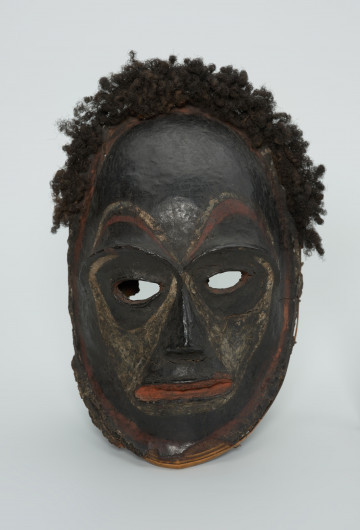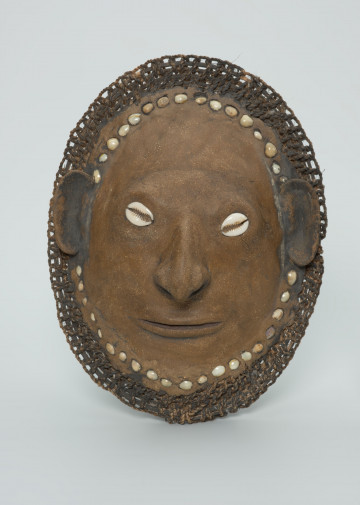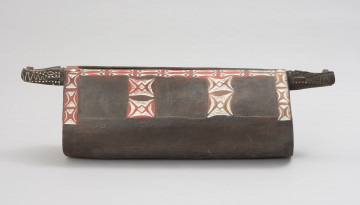
Skull mask
około 1891 — 1900
National Museum in Szczecin
Part of the collection: Art of Papua New Guinea
For generations, the Papuans living in New Guinea have lived in small and isolated villages. They constantly fought wars among themselves, in which shields and javelins were inseparable attributes. The shields and the other objects of worship to which they belonged were kept in the so-called Spirit Houses, Melanesian temples to which only initiated men had access. The ancestors 'inhabiting' the shields were consulted before deciding on a war expedition. The spirits actively joined the fight against the enemy, and by increasing the shields' protective power, they weakened the opponent, destroying his fighting spirit. The presented two-man atkom war shield was made by representatives of the Faiwolmin ethnic group living in the Western Province in Papua New Guinea. It is unique, as it was carved with a stone axe - other shields from the oceanic collection of the National Museum in Szczecin were made with metal tools. Its front is covered with a large, centrally placed butterfly motif, surrounded by a thicket of repetitive geometric figures. The zigzags on the sides imitate snakes, while the repeated lines in the upper and lower parts of the composition represent the jaws of a crocodile. The drawing was made with the champlevé technique, in which the pigment fills the cavities. War shields were often decorated with images of ancestors, drawings of faces of old, brave warriors. They were to be visible from a long distance so that enemies could easily read the symbolism hidden in them. Rich ornamentation was also a sign of the warrior's courage, as painted shields were quicker to catch the eye of enemies. With the cessation of wars, the appearance of the New Guinea shields changed. The big ones, whose role was to cover the whole warrior, became much smaller. They were given a purely ritual and symbolic meaning. The shield in question is a gift from Fr André Bouchard of the Catholic Mission in Kiunga. It found its way into the museum's collection thanks to the cooperation with Dr Maria Wrońska-Friend and her husband Anthony Friend. Wrońska-Friend is an ethnologist and anthropologist who lived and researched in New Guinea between 1981 and 1992.
Katarzyna Findlik-Gawron
Other names
atcom
Author / creator
Dimensions
cały obiekt: height: 157 cm, width: 67 cm
Object type
shield
Creation time / dating
Creation / finding place
Identification number
Location / status

około 1891 — 1900
National Museum in Szczecin

około 1980 — 1985
National Museum in Szczecin

1841 — 1860
National Museum in Szczecin
DISCOVER this TOPIC
Museum of King Jan III's Palace at Wilanów
DISCOVER this PATH
Educational path